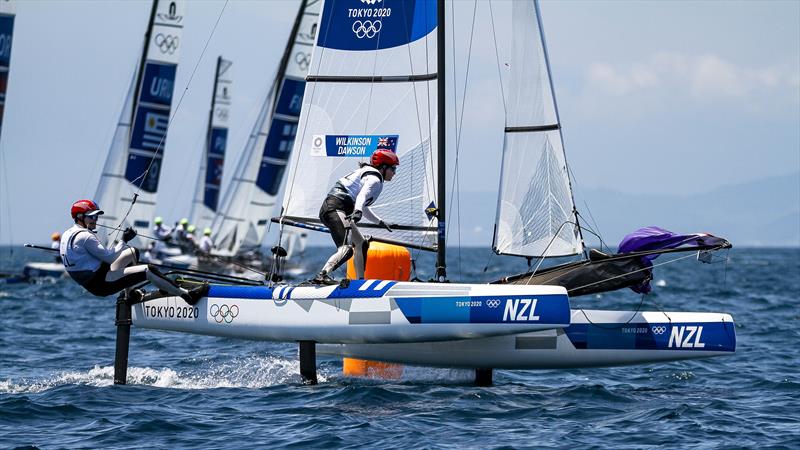
Getting sore eyes from your sunscreen - here's why
by Becky Cashman 5 Feb 18:26 NZDT

Micah Wilkinson and Erica Dawson sailing in the Nacra 17 at the Tokyo 2020 Olympic Regatta - Enoshima - August 2021 © Richard Gladwell - Sail-World.com/nz
The majority of sunscreens on the market are made with one seemingly innocent ingredient: dihydrogen monoxide. Said plainly, water.
Water is happy to mix with water, which makes three reasons why water in sunscreen formulations is a drawback.
One: When you apply water-based sunscreen to your forehead and eyelids and then sweat, you are witness to science at work. The water in your sweat mixes with the water in your sunscreen, creating a gloopy mess that runs into your eyes. And if your sunscreen also has chemical absorbers in it, you also have those chemicals in your eyes.
Two: Water in sunscreen mixes with the water that you swim in. And the sunscreen that you so carefully applied to your exposed skin, is now being washed off of your skin. This leaves you less protected in the sun.
Three: When water in sunscreen mixes with water that you swim in, it also washes all of the other ingredients into the water. This means the ocean now is now more loaded with whatever ingredients were used in the sunscreen. There are many chemical absorber ingredients that are considered toxic for the marine environment.
It turns out solving the problem of sunscreen running into eyes causing irritation and burning also solves the other two issues.
Use a highly water-resistant natural sunscreen.
Zinc oxide formulations have come a long way in the last decade with Kiwi innovation leading a new generation of sunscreen performance. The days of stiff, chalky white formulations are gone.
Kiwi company Goodbye spent six years learning to formulate a water-free natural sunscreen. Becky Cashman, founder and product maker knew that the best way to make a highly water resistant natural sunscreen was to leave water out of the formulation. “There was no base formulation already made by a lab. Because it hadn’t been done before, the process was frustratingly long, and at one point I actually walked away from it for a year.” It turns out the year away was the breakthrough.
When Cashman came back to the old formulations after taking a break, the ageing of the different batches gave her a clue. From there it was only another 12 months to full testing to the Australia/New Zealand sunscreen standard. They had cracked the code with a SPF 50 sunscreen with 2 hours of water-resistance.
The result is a silky, performance sunscreen. It settles transparently into the skin after about ten minutes and stays put, even on eyelids and lips. This might not be so important for the city days, but becomes critical in ocean activities.
Kiwi sailor Erica Dawson, bronze medal winner with Micah Wilkinson in Nacra 17 chose this sunscreen to protect her skin for the entire Olympic campaign. Self- described as having sensitive skin, Dawson is testimony to the performance of the natural sunscreen. Sailing a Nacra 17 requires wave-proof sunscreen capability. And with split second timing required, there’s no space for sunscreen sliding into eyes. "Sun Balm is hands down the best sunscreen I've ever used. I love how it doesn’t run into my eyes like other sunscreens, and it's natural so I can be confident using it on my sensitive face."
The best way to work and play on the water, is to keep it natural and keep the water out of your skin care.